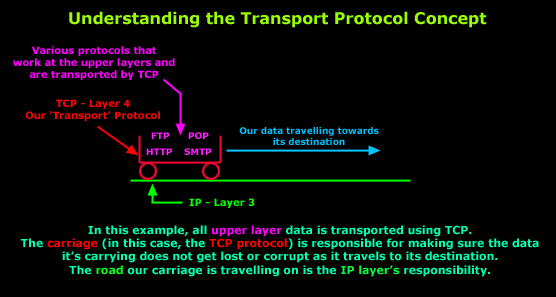|
The diagram below shows you where the TCP header is
located within a frame that's been generated by a
computer and sent to the network. If you rotate it
90 degrees to your left, you would get something
similar to the previous diagram. This of course is
because each layer appends its own information, or
header if you like:

The frame is made up of six
3d
blocks so you can see which
piece is added by every OSI layer. You can see that
the TCP Header
containing all the options the
protocol supports, is placed right after the
IP Header
(Layer 3), and before the
data
section that contains upper
layer information (Layers 5,6,7).
Note: For those who are
wondering about the presence of the
FCS
block at the end, it contains a special checksum
that is placed by the
datalink
layer in order to allow the receiving host to detect
if the current frame has been corrupt during transit.
Please refer to the
Ethernet II Frame page for
more information.
Where and why would we use the TCP ?
TCP is used in almost every type of network. As a
protocol, it is not restricted to any type of
network topology, whether it be a local area network
(LAN) or wide area network (WAN). Being a transport
protocol, we call it a transport protocol because
it's located in the transport layer of the OSI model
its primary job is to get data from one location to
another, regardless of the physical network and
location.
As most of you already know, there are two types of
transport protocols, TCP being one of them and UDP
(User Datagram Protocol) being the other. The
difference between these two transport protocols is
that TCP offers an extremely reliable and robust
method of transferring data, ensuring that the data
being transferred does not become corrupt in any
way. UDP, on the other hand, offers a non reliable
way of transferring data without being able to
guarantee the data has arrived to its destination or
its integrity when it does arrive.
The concept of a transport protocol
As we mentioned, TCP is a transport protocol and
this means it is used to transfer data of other
protocols. At first, this might sound weird or
confusing but this is exactly why it was designed,
adding substantial functionality to the protocols it
carries.
The diagram below is the simplest way to show the
concept of a 'transport' protocol:

In the pages to follow, we will have a closer look
at how TCP manages to provide its reliable data
transfer method and make sure packets get to their
destination without errors. This whole process is
the work of many 'subsystems' within the TCP that
work together to provide the reliability that TCP
gives us.
Before we dive in deeper though, let's have a quick
overall view of the protocol. If you're not
interested in too much technical detail, then the
next page is for you! For those looking for an
in-depth analysis, you should read the
quick-overview page to give you an idea on what we
will be analysing soon.
|
